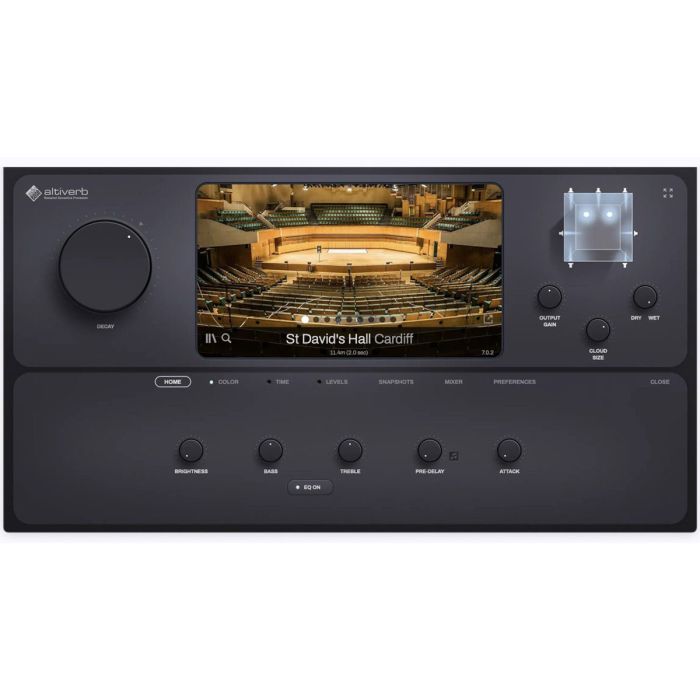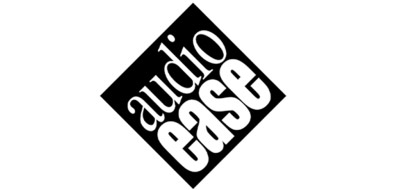This site uses cookies to provide you with the great user experience. Find out more here. By using this site you consent to use our cookies.
Audio Ease Altiverb 8 Regular Reverb Plugin
The original convolution reverb plugin
Altiverb is a plug-in that makes your audio sound as if it was played back somewhere else, adding the acoustics of existing spaces to your own recordings or to your live audio. All spaces in Altiverb were recorded in the real world, from Sydney Opera House to a Scottish underground oil tank the size of a cathedral.
The Original Convolution Reverb
Altiverb is a plug-in that makes your audio sound as if it was played back somewhere else, adding the acoustics of existing spaces to your own recordings or to your live audio. All spaces in Altiverb were recorded in the real world, from Sydney Opera House to a Scottish underground oil tank the size of a cathedral.
Altiverb Impulse Responses
From all over the world - Longer than anyone in the industry, and with more ear for detail, Audio Ease has been traveling the world to record the acoustics of the best sounding spaces.
The results of hundreds of these recordings are included with Altiverb 8.
Ranging from London's Wembley stadium to the ancient caves of the island of Malta and the churches, concert halls and rock studios from cities like Tokyo, Paris, Amsterdam, Berlin and New York.
The IR browser - The Impulse Response library is now more accessible then ever because of Altiverb's newly designed browser. Select impulse responses by clicking photos of rooms. Instant, gapless loading, finding similar sounding spaces, organise by reverb length (RT60), and single click favorites are just a few of the possibilities. The Impulse Response Browser and the pictures in it are resizeable and contains an extensive search field.
Concert halls - First class orchestral recording studios from the US East and West coast are featured in Altiverb, like Todd AO, 20th Century Fox, paramount, some of these studios do no longer exist, but their sound lives on in Altiverb.
Orchestral studios - First class orchestral recording studios from the US East and West coast are featured in Altiverb. Some of these scoring stages are no longer excistence, but their sound lives on in Altiverb.
Recording studios - Many world class recording studio live spaces and echo chambers, from Tokyo to Paris are part of the Altiverb impulse responses library.
Every day rooms - The POST category features many different sounding spaces, every day rooms like bathrooms, restrooms, kitchens, different types of transport, trains, cars, planes, but also the not so ordinary, odd sounding, spaces like museums, huge domes or sewer pipes.
Classic reverb gear
Altiverb contains a tremendous amount of classic reverb gear and purpose built echo chambers. You will find all the EMT plates you want, spring reverbs, classic digital gear like the 480, 224, the RMX 16, the 250. Add the Frank Sinatra and Beach Boys echo chambers and you have everything you need to recreate all those classic sounds.
Creating your own IRs
With the sweeps and tool you get with Altiverb 8 you can capture acoustics yourself and use these impulse responses in Altiverb. Please check the tutorial video and follow the tips to get best results.
Features
Apart from the extensive library of impulse responses you get with this plug-in, Altiverb features some clever controls for shaping the sound of this convolution reverb.
Decay - This essential reverb parameter is very prominent in Altiverb 8. You can apply an exponential decay on any impulse response to reduce the reverb time, without changing the character of the room.
Brightness - Real spaces often contain less high frequency content than algorithmic (synthetic) reverbs. Sometimes you need that extra sparkling brightness in a reverb tail that is just hard to obtain from the real world.
Damping - Control the reverb length of three separate and adjustable frequency bands. Shortening is damping, lengthening is enhancing. You can see the effect of damping in the waterfall graph of the impulse response.
Stage position
Altiverb can have mono or stereo inputs. When making impulse responses, we used either one speaker position in the center of the stage for mono input, or two speaker positions for stereo input. So there is a direct relation between the amount of inputs and the speakers used. Using the positioner tab, available only in mono and stereo input Altiverbs, you can switch on the speaker, in which case you can hear where it stands. You can also, right there, move the speaker around.
This is the absolute most realistic sounding virtual playback of your audio in any space in Altiverb.
You should use it fully wet, but even then you hear quite some dry-ish material, because there is a direct path from speakers to microphones. A demo of this is in the first minutes of the Altiverb 8 guided tour video.
The four knobs on the right manipulate the different stages of the impulse response, starting with the earliest part: the direct sound. The gain and color of the direct sound can be adjusted. Color is adjusted between neutral (flat) and the actual direct sound that is in the Impulse Response (IR), which sounds more realistic, but can give unwanted coloration as it can contain a very early reflection from an on stage piano or the stage itself, and also includes speaker and microphone coloration.
Early and tail can be switched on or off and the levels can be changed too.
Equalizer
Altiverb features a four band equalizer. The bass and treble bands are Baxandall EQs, designed to not shift phase more than 180 degrees, which effectively means that combing or cancellation effects are unlikely when the EQ’d signal is mixed with the dry signal. The equalizer works on the wet signal only.
Size
Makes the selected room (impulse response) smaller or larger. This transposes room modes and resonances, tightens or spreads early reflections, and shortens or lengthens the reverb tail.
Pre-delay
Delays the onset of the reverb. If the note symbol is clicked, the timing of the delay is locked to the tempo of the host application so you can select an eighth-note as the delay time.
Stage position
Altiverb XL supports more than two inputs. With more then two inputs there is no longer a direct relation between an input and a speaker that was used when making the impulse response. Therefore the Positioner tab is unavailable. Instead there is a new control: cloud size. With cloud size turned down, the reverb no longer outputs to all output channels, it starts clustering around the input pan position of your sounds. Even when the input sound moves, the reverb cloud travels along with it. The Altiverb 8 guided tour video gives an example of input pan following reverb starting at 5:43.
Attack
Fades-in the start of the impulse response, resulting in a more lush, distant reverb sound.
Reverse
The entire impulse response is reversed in time for backward reverb effects.
Modulation
This effect does not emulate anything that happens in reality, it emulates something that happens in artificial reverb algorithms.
Gated Reverb
Allows you to abruptly cut-off a reverb after a set amount of time. The gate time can also be locked to the tempo of the host application.
Mixer
Everything is recorded with enough microphones to provide Atmos reverb (up to nine eye level speakers plus six over head channels).
There's a new output meter and a mixer that provides full control of all outputs.
Snapshots
Snapshots are presets that are private to an instance of Altiverb. Read more...
What's New In Altiverb 8
- Native Apple silicon - M1 / M2 & Intel macs are fully supported.
- Dolby Atmos support - Up to 9.1.6 input and output channels for fully immersive convolution reverb. XL only
- New scalable user interface (except AU version)
- Cloud size - Automatic input-pan following reverb, locate each reverb around the panning of the source, even when multiple sources move in a single instance.
- Smooth and clickless - IR switches, reverb adjustments and stage position changes all practically seemless without any clicks.
- New output level meters - These allow manipulation of level and delay per output channel. XL only
- Pure Dolby Atmos IRs - Almost all of the hundreds of the music spaces (concert halls, churches, cathedrals, studios, scoring stages) have been upgraded to Dolby Atmos by utilizing the original extra recordings we have been routinely making throughout the years. All outputs of Altiverb are always real and distinct original speaker to microphone takes. XL only
- Mono pan following - Across surround busses up to Dolby Atmos (9.1.6), making multi-mono instances unnecessary, reducing session load time considerably. XL only
- Improved IR searching - The newly designed browser offers more and quicker ways to find the right IR.
- New IR Tool - This tool enables you to create your own IRs, with output support up to 9.1.6 channels.
- Computer activation - The Altiverb license can be activated on a computer or on a USB iLok key. The iLok USB key is NO LONGER required.
- VST3 Plug-In - To ensure compatibility with worldclass VST host applications (DAWs) like Ableton Live, Cubase, Nuendo and Digital Performer Altiverb 8 features a VST3 plug-in.
- Center - Almost all IRs have been supplied with a real center channel for LCR or 5.0 7.0 without center bleed.
- Backward Compatibility - altiverb 8 is fully backward compatible replacing altiverb 7 in your sessions.
- New Spaces - many new spaces are included with Altiverb 8, like the Zuidervermaning from the intro video, a dance club, some industrial spaces, a Tesla, camper vans , atmos plates and springs reverbs, and a selection of buckets and bins including a porta toilet. All including atmos.
- improved loading speed - Your sessions with many Altiverbs will load quicker than ever.
What's Not New in 8
Wait? What?
This is what Altiverb 8 continues to deliver, just like Altiverb 7 (and earlier) has been delivering for two decades:
- Backward compatibility, Altiverb 8 opens in sessions/projects that were made with Altiverb since 2006 and the session/project will sound the same.
- All IRs ever released for Altiverb.
- New IRs will be added regularly, for free.
- Fixes and support without yearly fees.
- The option to sell and transfer your license.
- Countless ways of manipulating the reverb sound with controls like reverb time, attack, brightness, pre delay, EQ, damping..
- Revolutionary stage positioning control for placing single members of a group, ensemble or even a complete orchestra on their own individual spot on stage, in any room/concert hall
| Specification | Specifications System requirements
macOS
Windows
8 GB free disk space
Tested host applications (DAWs) MacOS
Windows
Other DAWs might work too, only these have been tested
Plug-In formats
MAS
All plug-ins are 64 bits and on macOS Universal (ARM & Intel).
Altiverb 8 XL vs Altiverb 8 Regular Altiverb 8 Regular
Altiverb 8 XL
Altiverb 8 XL and Regular feature the same controls, the same IRs. Sessions made with Regular can be opened with XL (and the other way around), as long as the session is within the Regular limits (stereo & max 96kHz). |
|---|








